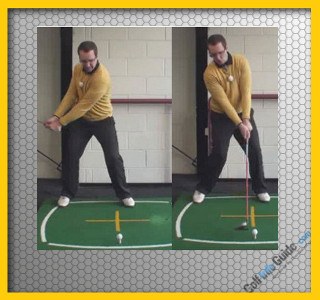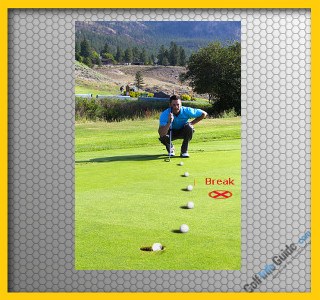Golf is a hard game to learn. Even the most-accomplished players in the game were once beginners, so every player knows the challenge of trying to get started in this famously difficult game. If you are currently in the process of learning how to play golf, you already know that every little tip you pick up along the way can be tremendously helpful. By paying attention and looking in a variety of places for advice, you can steadily improve your game until you are no longer in the category of beginner.
In this article, we have collected ten of the best golf tips every offered to beginners. You may have heard a few of these before, but it is always helpful to review good advice to make sure you are headed in the right direction. Once you think about these tips and how they apply to your game, you should be ready to head out to the course – whether for a productive practice session or an actual round.
All of the tips below are written from the perspective of a right handed golfer, so please take a moment to reverse the directions if you happen to play left handed.

#1 – Swing at Less than 100% Effort
It is only natural to swing as hard as possible when first getting started in this game. In fact, swinging at 100% effort is a habit that many golfers never manage to get out of, not matter how long they play the game. It might seem like a good idea to swing as hard as you can in order to maximize your distance, but swinging with such effort is going to do more harm than good.
Instead of swinging as hard as you possibly can, you should aim to swing most of your clubs at about 80 – 90% effort. Swinging at this level will still allow you to generate plenty of club head speed while also making it easier for you to stay on balance. Keeping your balance is a major key when it comes to solid ball striking, but you are going to have trouble staying balanced if you are always going after the ball with everything you have. Turn down the 'volume' on your swing by a 10 – 20% and you should find that your results quickly improve.
It should be noted that you are still going to be moving the club aggressively through the hitting area when you use this tip. No matter how hard you are swinging on a given shot, it is still important to use a full release through impact in order to sqaure up the club face and achieve a clean strike. Decelerating the club through the hitting area is never a good idea, so make sure you are committed to finishing each swing with confidence regardless of how much effort you have put into the shot.

It is extremely common for beginning golfers to play too-little break when reading their putts. For this reason, many pro golfers refer to missing a putt on the low side of the hole as missing on the 'amateur' side. A putt that is too low has absolutely no chance to go in, so start playing more break on your putts right away to give yourself a better chance to knock them in.
Of course, you can't talk about line without talking about speed when it comes to putting. Most likely, your current approach to putting includes hitting the ball too hard while not allowing for enough break. This is the classic amateur combination, and it leads to more three putts than anything else. Since you aren't playing enough break, you will be compelled to hit the ball harder than necessary in the hopes of holding the line. In the end, the ball will still miss low but it will also race past the cup because you have hit it so hard.
The adjustment that is needed here is obvious – you need to play more break while also hitting your putts with less speed. Hitting your putts softer will give the ball more time to take the break that you are playing, so give the ball plenty of room to move back toward the hole and try to drop it in on the high edge. During your next practice putting session, work on hitting your putts with perfect speed so that the ball stops right next to the cup – if it doesn't fall in. It will take a bit of time to break the habit of using too much speed, but you should be able to see progress within your putting performance after just a few practice sessions.

Many new golfers put the 'cart in front of the horse' when it comes to learning how to swing the club. In a rush to play at a high level, many players will start to work on advanced swing techniques before they have even mastered the basics. Not surprisingly, this is going to lead to trouble. You need to have patience when first getting started in golf, as there are no shortcuts to success in this game. Instead of quickly moving on to complicated mechanics, take as much time as necessary to completely master the basics of the swing.
What are the basics that you should be taking time to learn? The following list is a good place to start –
The basics of the swing might not be particularly exciting, but they are certainly effective. If you manage to hit on all four of the points listed above, you should be able to play some pretty nice golf even without going any further.

#4 – Use a Conservative Strategy
Most new golfers have watched the game on TV at least a few times before they venture out onto the course for themselves. So, with that experience of watching top players hit great shots in the back of their mind, new golfers often use a strategy that is too aggressive for their modest skills. Professional golfers are able to hit brave shots over hazards and other obstacles because they have finely-tuned swings and experienced nerves. You don't have either of those things at this point, so a conservative strategy is going to be your best friend.
What does it mean to play conservative out on the course? Basically, you are going to be picking targets that give you a maximum margin for error. As a beginner, you can't reasonably expect to be highly accurate with your shots, so don't aim at targets that require perfection from your swing. Instead of aiming close to the edge of a water hazard or bunker, aim safely away and allow yourself to be a little off track without getting into trouble. As time passes and you gain more and more confidence in your game, you can gradually start to be more aggressive with the targets that you use during your rounds.

#5 – Practice Your Short Game More Than Your Full Swing
As a recreational golfer, you have limited practice time at your disposal. So, to make sure you improve as quickly as possible, you need to divide that practice time wisely between the various parts of your game. Unfortunately, most amateurs do a poor job of dividing their time, spending way too much time on the driving range and not nearly enough on the putting green.
As a general rule of thumb, you should spend at least as much time practicing your short game as your long game, if not more. So, if you are going to hit balls on the range for 30 minutes, you should plan on having at least 30 minutes free to putt and chip. Only have 30 total minutes to practice? Try hitting balls for 10 minutes while spending the rest of the time on your short shots.
The short game is important for golfers of all skill levels, but it is especially key for players who are just getting started. Realistically, it is going to take some time for you to be able to improve on the quality of your full swing and your ball striking. However, the nature of the short game is such that you can actually improve quite quickly as you gain experience. Put in plenty of time on your putting and chipping and you will be rewarded with vastly improved performance out on the course.

Golf is a hard game even with the right clubs in your hands – it is nearly impossible when you are playing with clubs that are ill-suited to your swing. Many people get started in the game by using clubs they got from a friend or purchased from a second-hand store. While it is certainly understandable to want to get started with an affordable set, you also need to make sure that set fits your swing properly or you will be making the game even harder than it already is.
So do you need to spend thousands of dollars on a custom set in order to play good golf? No, not at all. You can feel free to purchase a set of used clubs for a discount, or a set of new clubs from a low-cost brand. However, after you acquire those clubs, it would be a good idea to head to a professional club fitter who can tweak them in order to fit your needs. A session with a club fitter should be a relatively affordable experience, and it can pay off in a big way when you notice how well your clubs now fit your needs.

Many golfers refer to the forward tees as the 'ladies tees', but that name is a little bit misguided. The forward tees don't need to be gender specific, as they are well-suited for anyone who is going to have trouble handling the course from farther back. There are plenty of women who can play golf from the back tees, and there are plenty of men who would be better served by playing from a shorter distance.
When you are first getting started, you want to make the game as easy as possible in order to facilitate a little bit of success. If you step up to the forward tees in order to make the course a little easier, you will be more likely to have fun and record a decent score that you can be proud of. Don't worry – those back tees aren't going anywhere, and you can always move back for a greater challenge as your skills improve and you gain confidence. It doesn't matter whether you are a man or woman, the forward tees are a great place to get started with your golf experience.

There is a lot of golf instruction available these days on TV and on the web, but there is nothing quite like taking a one-on-one lesson from a local golf pro. Nearly every golf course has at least one or two pros on staff, and these teachers will be happy to help you with your game. Golf lessons are not particularly expensive, and they are a great way to get your swing moving in the right direction. Sure, you can probably teach yourself to play this game over time, but working with a pro should speed up the learning curve dramatically.
When setting up your first lesson, look for a teacher in your area that specializes in working with beginners. Call around to a number of local courses and ask about the lesson options that they have available for new golfers. You may even wish to take a single lesson with a couple of different teachers before settling on one that you are going to use on an ongoing basis.
Your teacher should be able to work with you on many of the basic fundamentals of the game such as grip, stance, balance, tempo, and more. It is tremendously helpful to have an experienced pro watching you practice while catching your mistakes in real-time. Most pros will send you away after each lesson with specific points to work on, so you can practice between lessons in order to accelerate your progress. If you are willing to invest a bit of time and money into a lesson program, the rewards can be impressive.

It can't be overstated just how difficult the game of golf really is. You are likely to never take up another hobby which is as challenging as golf, so you should go into it with the understanding that you are going to make plenty of mistakes along the way. Instead of beating yourself up for the poor shots that are inevitably going to come as you learn the game, try to relax and be nice to yourself throughout the journey.
Why is it important to be nice to yourself as you learn the game? Simple – having a good attitude will help you to play better. There is no use in getting frustrated with yourself after hitting a few bad shots, as that frustration will only make it harder to focus on the things that are going to allow you to improve. Setting aside your emotions is not always going to be easy while you practice and play, but that is exactly what it needed to raise your level of performance.
To help yourself keep the right attitude on the course, remember that golf is just a game. Sure, you want to learn how to play well, but it is still a game at the end of the day. You are picking up the game to have fun, get some exercise, spend time outdoors with friends, etc. It is unlikely that you are trying to make a career out of playing professional golf, so there is no need to take it too seriously. You can absolutely work on making yourself a better player, but always keep the game in perspective and remember to have fun at every turn.

If you want to consistently improve on your performance as you move forward in the game, one of the best things you can do is to set goals for yourself along the way. At first, these goals will be simple and minor – perhaps you want to simply make one par during a round, or you want to hit three greens in regulation over the course of 18 holes. As you get better, those goals will need to become more challenging, as your early goals will seem easy to achieve. Smart goal setting always sets the mark at a point that is reasonable to achieve but yet still difficult to reach.
At first, you should do your best to avoid setting goals that are related to your overall scores. Your game is going to be wildly inconsistent early in your golf experience, so it will be tough to set smart goals related to total scores. As you gain experience and get a few rounds under your belt, you will start to get a better understanding of your abilities and what to expect in the way of scores. Once you have played at least a few full 18 hole rounds, you can start to add total score goals to your list of desired accomplishments.
It is important to remember that golf is an individual game and the goals you set for yourself should not be influenced in any way by other players around you. For instance, if you think a good goal for yourself would be to break 100 during one of your upcoming rounds, you should set that goal and work hard to achieve it. Even if others in your group are shooting scores in the 90's and trying to break into the 80's, you shouldn't be tempted to adjust your own target as a result. Stick to your own plan, be proud of your own accomplishments, and take a slow and steady approach to developing a better game.
Golf is one of the greatest games in the world, but it can be quite difficult for the beginner to learn and enjoy. To get to a point where you are truly able to enjoy the game, you need to stick it out through the tough times that are likely to be found at the start. Be patient with yourself, work hard on the fundamentals, and get help from a professional when necessary. It might feel like a long process, but you should start to see progress in your game after a relatively short period of time. Once you see that progress, you will likely become addicted to the feeling of success, and you will want to work even harder to reach new heights. Good luck and have fun!






